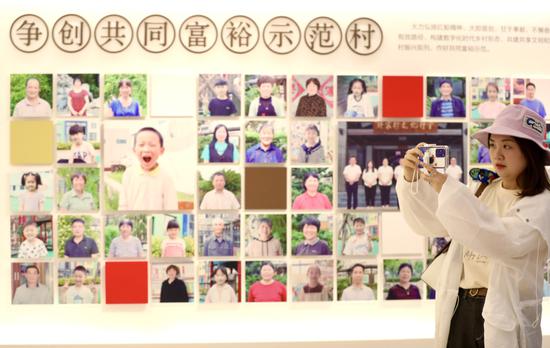
A journalist takes photos at a village history hall in Jiaxing, East China's Zhejiang province, on July 12, 2021. (Photo by Zhu Xingxin/chinadaily.com.cn) China's modernization drive differs in many ways from efforts to develop and modernize in other parts of the world, with the fundamental difference being its emphasis on common prosperity, experts said. The report to the 20th National Congress of the Communist Party of China in October reiterated the Party's goal of turning the nation into a fully modernized socialist country by 2050. The way to reaching that goal is also made clear: through the Chinese path to modernization. The report listed five characteristic features that make China's modernization drive special, such as involving the world's largest population; seeking harmony between humanity and nature; and, because it's the modernization of peaceful development, avoiding the old path of war and colonization. "Seeking common prosperity is the founding mission of the Party and the most essential feature of a socialist society," said a commentary published on Aug 30 in Economic Information Daily. "The quest for common prosperity will last throughout China's modernization process," it stated. The commentary, which was also published on the website of the government of Zhejiang province, said that the drive's "core essence" rests on its ability to deliver prosperity to all. The province is a wealthy manufacturing hub in East China and was designated as a common prosperity pilot zone in 2021. The concept of common prosperity was put forward by former leader Deng Xiaoping after he launched the reform and opening-up policy in 1978 and allowed some Chinese people to become better off first. Deng said in 1985 that some regions and some people were encouraged to become better off first, and the aim is to let them help more people improve their standard of living and achieve common prosperity. Common prosperity gained much relevance in August last year at the 10th meeting of the Central Committee for Financial and Economic Affairs. Presiding over the meeting, President Xi Jinping said that realizing common prosperity is the essential requirement of socialism and is also an important feature of China's modernization. The meeting's participants said efforts should be made to expand the middle-income group, increase the incomes of lower-income groups and rationally adjust higher incomes in order to enhance social fairness and justice and promote people's all-around development. The purpose, they said, is to ensure that all people will march toward common prosperity. The efforts to curb poverty and strengthen safety nets over the past decade — the major moves to ensure common prosperity — were lauded at the two-day annual Central Economic Work Conference, which concluded on Friday. The tone-setting annual meeting is closely watched for its central role in planning the country's economic performance in the coming year. The meeting's participants agreed that China's success in ending absolute poverty pushed the country to a "new, higher historical starting point" as it seeks full modernization. In the coming year, participants also underlined the need to ease the impact of rising consumer prices on vulnerable groups in a timely and effective manner, continue building a nationwide pension system and guide quality health resources to expand and become firmly rooted in rural regions. Zhang Lianqi, a member of the Standing Committee of the 13th National Committee of the Chinese People's Political Consultative Conference, wrote in a commentary this month that a widening wealth gap is a major factor hindering development in many countries, and solving the problem is a world-class difficulty. Hard as it is, China has made continuous progress on that front. Data from the National Bureau of Statistics showed that the urban-rural wealth gap has kept narrowing ever since the 18th National Congress of the CPC in 2012. Disposable income in rural areas increased 125.7 percent between 2012 and last year. In comparison, it grew in urban areas by 96.5 percent. In 2021, disposable income in urban areas was 2.5 times that in rural areas, compared with 2.88 times in 2012. The progress came after China successfully pulled nearly 100 million rural residents out of poverty over the decade since 2012. China also managed to create the world's largest social safety net. The basic old age insurance program, China's pension fund system, expanded since 2012 to cover 1.04 billion people this year. The coverage of unemployment benefits and work injury insurance also soared, reaching 230 million and 290 million people, respectively, official figures showed. A commentary by Huang Qunhui, director of the Economic Research Institute of the Chinese Academy of Social Sciences, said that China's pursuit of common prosperity is what made the country's modernization drive significantly different from such efforts by capitalist nations in the West. "Common prosperity is the antonym of polarization between the rich and poor," he wrote. "However, it is not the synonym of egalitarianism." As a process, common prosperity means common development. All the people have the right and opportunity to pursue development and get better off through hard work, he added. |
Powered by Discuz! X3.4 Licensed
© 2001-2013 Comsenz Inc.